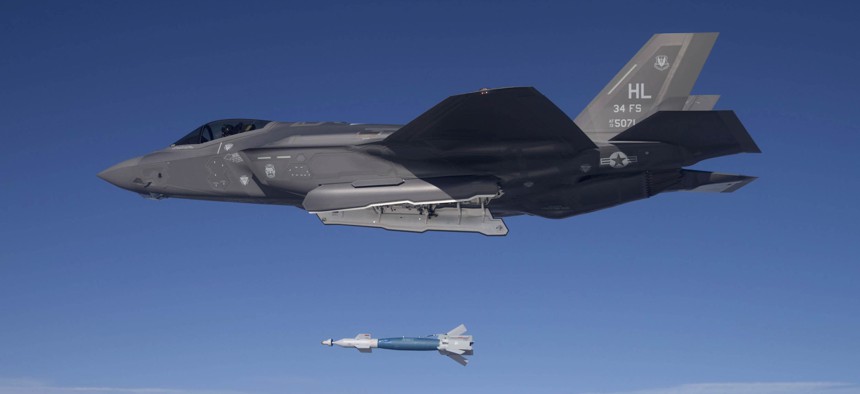
Lt. Col. George Watkins, the 34th Fighter Squadron commander, drops a GBU-12 laser-guided bomb from an F-35A Lightning II at the Utah Test and Training Range Feb. 25, 2016. U.S. Air Force / Jim Haseltine
The US Air Force Needs F-35s, Not the F-15EX
Only about 20 percent of USAF fighters are fifth-generation aircraft. Winning tomorrow’s wars depends on growing that share faster, not slower.
The U.S. Air Force needs more fighter aircraft and it needs them fast. The current fleet is too old and too small to guarantee the air superiority that deters potential adversaries and is essential to win wars. To reverse this dangerous state of affairs, Congress must alter the Pentagon’s proposed 2020 budget by adding F-35As, dropping the plan to buy the F-15EX, and funding the development of a next generation of air-dominance technologies.
The F-15 and F-16 were designed in the closing days of the Vietnam War, and the Air Force and industry did a fantastic job. But today, the average Eagle or Viper is more than three decades old, far past its intended service life, and is literally wearing out from structural fatigue. They are also unable to penetrate modern defenses and get home safe. Adversaries have had 40 years to tune their systems to counter these jets.
The Air Force never intended to find itself facing an air-superiority crisis. It was supposed to buy 750 F-22s in the 2000s, followed by 1,763 F-35As. Both aircraft were designed with stealth attributes to foil modern enemy air defenses, plus sensors, processors, and the ability to collaborate with a wide variety of combat assets. These “fifth-generation” technologies reshaped combat aviation, much as landlines gave way to the smartphones that have reshaped society. Aircraft without these attributes are irrelevant.
However, the Air Force’s fighter plan hit severe turbulence. The F-22 arrived in 2005, years late. The military, immersed in the generally low-tech yet costly Afghanistan and Iraq wars, ended production after just 187 jets, less than half the stated requirement. As for the F-35, delays and a host of program challenges have left the Defense Department more than 1,000 aircraft short.
Related: The F-35 Is About to Get A Lot Smarter
Related: China’s Copycat Jet Raises Questions About F-35
Related: Lockheed Martin is Waging War on Boeing’s F-15EX
To fill the gap, the Air Force has flown its F-15s and F-16s decades longer than planned. The oldest of these fighters, the F-15Cs, will not make it to the end of the decade. More than 200 of these aircraft will be retired in the next few years, and those that remain will be of decreasing combat utility. Meanwhile, F-22s and F-35s will be flown exceedingly hard to meet burgeoning operational demand. We are on course to a collapse in a core U.S. military competency.
The obvious solution to this problem is to increase production of the Air Force’s most advanced design currently in production: the F-35. “We find ourselves in a position where we’ve got to buy 72 aircraft a year,” said Gen. Dave Goldfein, the Air Force chief of staff. That is attainable. Lockheed Martin’s production line is currently budgeted to build 48 F-35As in 2020. Service and industry officials say it can be accelerated to produce 60 aircraft next year, 78 the following year, and even more after that. This comes as the F-35 program hits its stride, enabling the service to get increasingly capable aircraft for less money.
It is important to note that the 2019 budget slated the Air Force to buy a total of 264 F-35s over five years. The Office of the Secretary of Defense decided to change this plan. Its 2020 budget proposal now before Congress calls for buying just 48 F-35s annually for the next five years, for a total of 240. It also calls for buying eight F-15EXs in 2020 and a total of 80 over five years.
While OSD’s plan would buy 56 more jets over five years, buying fourth-generation aircraft that do not meet the full spectrum of modern combat requirements spends money for a marginal return and puts airmen in the sky at far greater risk. It is true that new Eagles have far better sensors, processors, defenses, and cockpit interfaces than the Air Force’s current jets, but the airframe design is more than 40 years old and cannot be upgraded to current stealth standards.
Nor is there a cost argument to be made for the F-15EX. It costs roughly the same to purchase as an F-35, and will soon cost no less to operate as the newer plane matures in service. More non-stealthy F-15EXs would be required to execute a combat mission against modern defenses than F-35s — and more would be lost. Losing jets and pilots does not save money.
An argument might be made for quickly buying F-15EXs to replace F-15Cs as a short-term stop-gap measure, but this is not the plan. The first two new Eagles would arrive in 2023 for testing, with further aircraft joining operational units in the middle of the 2020s and beyond. Yet these 80 aircraft are a far cry from the 200-plus F-15Cs that will be retired.
Today, only about 20 percent of the Air Force’s fighters are fifth-generation aircraft. Success in tomorrow’s wars depends on growing that share faster than currently planned, not slower. Now is not the time to waste precious defense dollars buying an aircraft that will put both airmen and the nation’s interests at risk. Congress must block the proposed F-15EX procurement, accelerate F-35 production, and spend more money developing the next generation of air-superiority technologies.
NEXT STORY: Ep. 42: Escalating in Somalia



